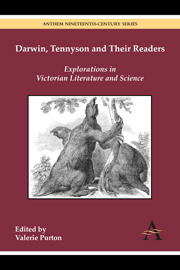Book contents
- Frontmatter
- Contents
- Introduction
- Chapter 1 Tennyson's ‘Locksley Hall’: Progress and Destitution
- Chapter 2 ‘Tennyson's Drift’: Evolution in The Princess
- Chapter 3 History, Materiality and Type in Tennyson's In Memoriam
- Chapter 4 Darwin, Tennyson and the Writing of ‘The Holy Grail’
- Chapter 5 ‘An Undue Simplification’: Tennyson's Evolutionary Afterlife
- Chapter 6 ‘Like a Megatherium Smoking a Cigar’: Darwin's Beagle Fossils in Nineteenth-Century Popular Culture
- Chapter 7 ‘No Such Thing as a Flower […] No Such Thing as a Man’: John Ruskin's Response to Darwin
- Chapter 8 Darwin and the Art of Paradox
- Chapter 9 Systems and Extravagance: Darwin, Meredith, Tennyson
- Chapter 10 T. H. Huxley, Science and Cultural Agency
- Notes on Contributors
Chapter 3 - History, Materiality and Type in Tennyson's In Memoriam
- Frontmatter
- Contents
- Introduction
- Chapter 1 Tennyson's ‘Locksley Hall’: Progress and Destitution
- Chapter 2 ‘Tennyson's Drift’: Evolution in The Princess
- Chapter 3 History, Materiality and Type in Tennyson's In Memoriam
- Chapter 4 Darwin, Tennyson and the Writing of ‘The Holy Grail’
- Chapter 5 ‘An Undue Simplification’: Tennyson's Evolutionary Afterlife
- Chapter 6 ‘Like a Megatherium Smoking a Cigar’: Darwin's Beagle Fossils in Nineteenth-Century Popular Culture
- Chapter 7 ‘No Such Thing as a Flower […] No Such Thing as a Man’: John Ruskin's Response to Darwin
- Chapter 8 Darwin and the Art of Paradox
- Chapter 9 Systems and Extravagance: Darwin, Meredith, Tennyson
- Chapter 10 T. H. Huxley, Science and Cultural Agency
- Notes on Contributors
Summary
This chapter aims to unpack and provide a context for the puzzling amalgam of organicism and historicism to be found in the last lines of Tennyson's In Memoriam. In those lines, the poem prophesies the evolution of humankind into a ‘crowning race / […] / No longer half-akin to brute’ (‘Epilogue’ 128, 133). With respect to the time of this future race, ‘all we thought and loved and did, / And hoped, and suffered, is but seed / Of what in them is flower and fruit’ (134—6). The tense shift in line 135, which contemplates the events of the poem and the grief and hope it expresses both in the present and from a standpoint of historical retrospect, dramatizes a split temporality which I will argue both characterizes the poem as a whole and also ultimately comes to define its representation of Tennyson's dead friend Hallam, the elegy's subject. In the poem's final mention of him, Hallam appears with respect to the crowning race to come as ‘a noble type / Appearing ere the times were ripe’ (138—9). In spite of its reference to ripeness, and the mentions of seed, flower and fruit in the lines immediately preceding, the temporality in which these lines set Hallam is not that of the vegetative cycle but that of history.
- Type
- Chapter
- Information
- Darwin, Tennyson and their ReadersExplorations in Victorian Literature and Science, pp. 35 - 48Publisher: Anthem PressPrint publication year: 2013



